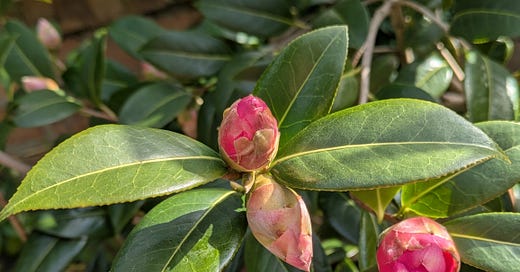I didn’t know what a camellia was until we bought our house and inherited a flower garden. That spring I marvelled at their rose-like blooms which appeared exactly when I was most in need of some colour. I fell in love hard and fast.
Sadly, I pruned them at the wrong time and in the wrong way and the following year they barely bloomed. It’s not the only mistake I’ve made. Camellias are sensitive souls and need very particular care at very particular times of the year. Among other requirements, they need to be watered thoroughly during late summer (it’s the time when next year’s buds are developing), they don’t like morning sun (it can burst or damage their buds) and they don’t like a late winter frost (it can make their buds and blooms drop).
This might make camellias seem high maintenance but most of a camellia’s needs are easily tended once you understand them. Once I realised they didn’t like being against the east facing wall of the garden, I dug them up and replanted on the other side of the garden and, having found out about their need for water in late summer, I focused my hose pipe on them for a couple of weeks each August. Their dislike of a late winter frost is more problematic. I suppose I could wrap them in fleece for the winter but the danger time is right when they start to bloom, which is exactly when you’d be removing the fleece anyway. I take my chances, leave them naked to the elements and hope for the best.
This winter has seen Bedford cold and grey but not particularly frosty. So far so good - for the camellias at least. But last week although the sky was (finally) blue and the afternoon temperatures warm, the days arrived with a bloom-threatening frost. Disaster. Every morning when I opened the blinds and saw the Velux window covered with a sheet of ice crystals my first thought was for the camellias. This week hasn’t been much different and my weather app tells me to expect more frosts in the coming days. Each day that I’m in the garden I touch the buds of my camellias and hope that the warmth of my care will be enough to protect them overnight.
If this sounds like eccentric behaviour, I understand but I have a hunch that wandering around your garden, touching buds and wishing them well is not uncommon, at least not amongst those who see gardening as a spiritual practice. Yesterday, as I checked in with my camellias, I remembered this poem by Joyce Rupp and smiled.
Spring Flowers
Joyce Rupp
Last night after sunset
I put my flower children to bed,
covered their cheery pink faces
with blankets, towels and sheets,
said, “Goodnight, stay warm,
don’t let the frost-bugs bite,”
hoping, when I arose next day,
that the long cold night
had not nipped their spring noses
and frightened them to death.
How carefully I care
for the small flower garden,
protecting all I can from harm.
Yet, when the green shoots
of my own inner growth
push their way out,
I seem to leave all to chance
and little to care.
I wonder why.
Joyce Rupp is one of my favourite spiritual guides and it fills me with delight to know that she walks around her garden talking to her flowers and hoping an overnight frost will not “nip their spring noses”. At a deeper level, though, what moves me in this poem is the connection she makes between the beloved flowers of her garden and the green shoots of her inner growth. As I stepped back into the warmth of my house having said goodnight to my own flower children, I pondered how I attentive I am to the green shoots of growth within myself and whether, like Joyce,1 I “leave all to chance and little to care”.
I’ve been mulling this over and I think the truth is that I don’t just leave the growth of my inner green shoots to chance - I rarely even look to see what’s sprouting. While I’m diligent in noticing what’s dying or missing in me, and I’m getting better in noticing what’s flourishing, I am fairly negligent when it comes to noticing the green shoots of possibility. I think it’s because I don’t look long enough to see what’s springing up from the soil of my soul. Like Joyce Rupp, I wonder why.
I don’t have a full answer but I think, perhaps, it feels vulnerable to acknowledge those tender places of becoming. I think it feel risky to notice what’s beginning to grow within and hope that their green shoots may really become something. I mean, what if they don’t? What if the growth I think I’m glimpsing turns out to be nothing new at all? Perhaps that’s also part of an answer to why I don’t offer care to the shoots when I do notice them. If an inner frost comes and the shoots of what is becoming wither and die, the care I’ve offered might turn to disappointment - or even grief. It feels safer to leave things to chance and not hope for anything at all.
Whatever the reason I tend to neglect the green shoots of inner growth, I’m ready to try a different approach. I remember the tenderness with which I touch the buds on my camellias and I'm curious what it would be like to invest as much care in the green shoots of inner growth as I do in my spring garden. What would that care look like, I wonder? And what difference might it make?
Reading the poem again, I'm struck by how Joyce says goodnight to her flower children:
“Goodnight, stay warm/don’t let the frost-bugs bite.”
It sounds like a blessing and it makes me wonder what it might be like to bless the becoming of our own inner growth.
Joyce’s words to her flower-children aren’t complicated and I don't think the words we speak over our inner lives need to be complicated either. It’s enough to simply speak a few words of acknowledgement and encouragement over the tender shoots of growth we see in ourselves. A shoot of confidence, for example, or a shoot of forgiveness or a shoot of acceptance.
Blessing these inner shoots won't ensure they don't get nipped by an inner frost any more than saying goodnight to your camellias will prevent them from being damaged by a cold night but I choose to believe that it will strengthen them somehow. I can't prove that. It's an intuitive knowing rooted in trust. It’s the same knowing that's there when I touch my camellia buds and hope that they will be warmed - and perhaps even a little protected - by the care that in that moment is flowing through me.
I say “flowing through me” because sometimes, when I’m in my garden, I feel as though I am connected not just to the plants but also to all those who have tended them through the generations. I connect to a care that is bigger than mine alone - the care shared by every gardener and which doesn't exactly belong to us but flows to and through us. A Divine flow of care that enables us to do the holy work of tending things as they become all they are. A care of blessing that says I see you, I honour you, I want you to continue to be and become.
I wonder what it would be like to tune into that flow of care and offer it to the inner growth in ourselves.
I wonder what green shoot of becoming in me - and in you - might be asking to be blessed.
I hope she won’t mind me using her first name - it was my Nana’s name too and I love it.








"A Divine flow of care that enables us to do the holy work of tending things as they become all they are."
Oh I love this phrase Jen. I've been pondering the words attending and tending for my own life and how I treat myself. Thanks for this 'tender' image.
Thank you for this reminder, gently wrapped in such lovely packaging.